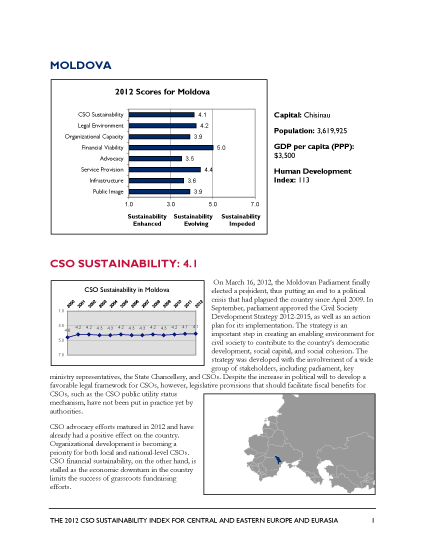CSO SUSTAINABILITY: 4.1
On March 16, 2012, the Moldovan Parliament finally elected a president, thus putting an end to a political crisis that had plagued the country since April 2009. In September, parliament approved the Civil Society Development Strategy 2012-2015, as well as an action plan for its implementation. The strategy is an important step in creating an enabling environment for civil society to contribute to the country’s democratic development, social capital, and social cohesion. The strategy was developed with the involvement of a wide group of stakeholders, including parliament, key ministry representatives, the State Chancellery, and CSOs. Despite the increase in political will to develop a favorable legal framework for CSOs, however, legislative provisions that should facilitate fiscal benefits for CSOs, such as the CSO public utility status mechanism, have not been put in practice yet by authorities.
CSO advocacy efforts matured in 2012 and have already had a positive effect on the country. Organizational development is becoming a priority for both local and national-level CSOs. CSO financial sustainability, on the other hand, is stalled as the economic downturn in the country limits the success of grassroots fundraising efforts.
Civil society development in the breakaway region of Transnistria did not improve after the new president came to power in 2011. CSOs still struggle to survive in a hostile environment in which authorities harass and ignore them. Transnistrian CSOs continue to rely on foreign funding, although they increasingly demand support for their activities from public authorities.
According to the Registry of Non-commercial Organizations, there are 6,884 CSOs registered at the national level in Moldova, an increase of 699 over the past year. The total number of Moldovan CSOs, including those registered locally, is over 9,500, a quarter of which are estimated to be active. Approximately 2,500 CSOs are registered in Transnistria, but only 500 of these are estimated to be active.








Comment
Make a general inquiry or suggest an improvement.